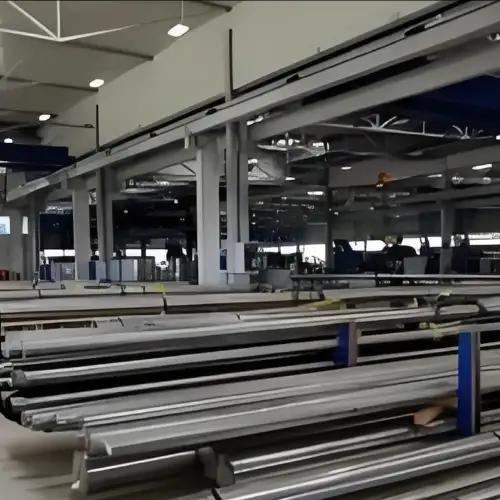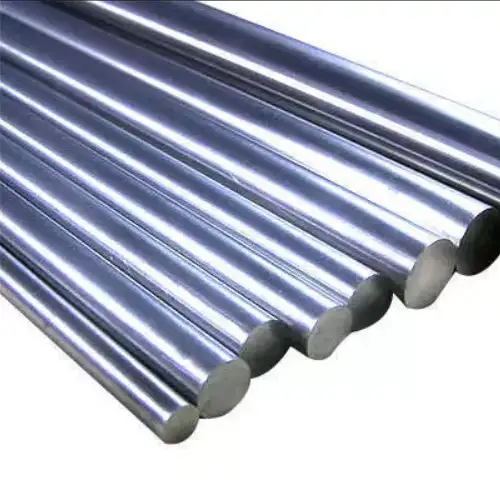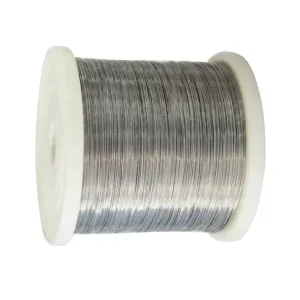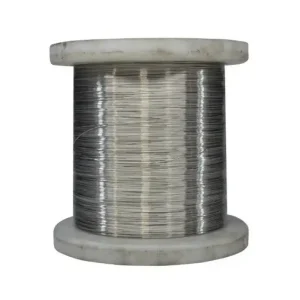At MWalloys, we manufacture and supply high-performance Inconel Alloy 625 bars to meet the world’s most demanding industrial needs. Engineered for extreme environments, this nickel-based superalloy offers outstanding resistance to high temperatures, corrosion, and mechanical stress. It’s not just a material—it’s a solution trusted across aerospace, marine, power generation, and chemical processing industries.
What Is Inconel Alloy 625 Bar?
Inconel® Alloy 625 is a corrosion- and oxidation-resistant nickel-based superalloy containing significant amounts of chromium, molybdenum, and niobium. Designed for high-strength applications up to 1000°C (1832°F), it exhibits exceptional fatigue strength, creep resistance, and weldability.
We produce Inconel 625 bars in both hot-rolled and cold-drawn conditions, tailored for critical applications where failure isn’t an option. From sub-sea valves to aircraft exhaust ducts—this alloy performs where others fail.
Standard Overview & Key Properties
*(Inconel 625 / UNS N06625 / W.Nr. 2.4856)*
| Parameter | Specification | Key Notes |
|---|---|---|
| Scope | Nickel-chromium-molybdenum-niobium bars for extreme corrosion/oxidation resistance (-253°C to 1093°C) | Superior pitting & chloride SCC resistance |
| Conflict Priority | 1. Purchase Order > 2. Product Spec > 3. ASTM/AMS Standards | Mandatory tests: hydrostatic, ultrasonic |
| Grades | Grade 1 (Annealed): General industrial use Grade 2 (Solution Annealed): High-temp/pressure applications |
Grade 2 required for ASME pressure vessels |
| Key Advantages | • Corrosion Resistance: Immune to chloride stress cracking • Strength: 827 MPa tensile (min) without heat treatment • Weldability: No post-weld cracking |
9x cost of 316 stainless steel |
🔬 Chemical Composition
(Weight %, Melt Analysis per ASTM B446)
| Element | Min | Max | Role | Permissible Variation |
|---|---|---|---|---|
| Ni | 58.0 | - | Austenitic matrix stability | ±0.5% |
| Cr | 20.0 | 23.0 | Oxidation resistance | ±0.3% |
| Mo | 8.0 | 10.0 | Solid-solution strengthening | ±0.2% |
| Nb+Ta | 3.15 | 4.15 | Primary strengthening (γ″ phase) | ±0.1% |
| Fe | - | 5.0 | Cost reduction | ±0.1% |
| C | - | 0.10 | Carbide control | ±0.005% |
| S | - | 0.015 | Weldability risk | ±0.001% |
💡 Critical Insight: Nb+Ta content (3.15–4.15%) enables stress-free welding and eliminates post-weld heat treatment.
💪 Mechanical Properties
(Room Temperature, Annealed Condition per ASTM B446)
| Property | Grade 1 (Annealed) | Grade 2 (Solution Annealed) | Test Standard |
|---|---|---|---|
| Tensile Strength (min) | 827 MPa (120 ksi) | 827 MPa (120 ksi) | ASTM E8/E8M |
| Yield Strength (0.2%) | 414 MPa (60 ksi) | 414 MPa (60 ksi) | ASTM E8/E8M |
| Elongation (min) | 30% | 30% | ASTM E8/E8M |
| Hardness (max) | 287 HBW | 241 HBW | ASTM E10 |
| Density | 8.44 g/cm³ | 8.44 g/cm³ | - |
⚙️ High-Temp Performance: Retains 480 MPa tensile strength at 704°C (1300°F).

📏Dimensional Tolerances & Common Sizes
(Per ASTM B446 & AMS 5666)
Bar Shapes & Standard Dimensions
| Shape | Diameter/Thickness | Length | Tolerance |
|---|---|---|---|
| Round Bar | 12.7–254 mm (0.5–10") | 1000–4000 mm | ±0.1 mm (≤50mm), ±0.2% (>50mm) |
| Hex Bar | 10–100 mm | 1000–3000 mm | ±0.15 mm |
| Flat Bar | 5–50 mm (thickness) | 2000–6000 mm | ±0.2 mm |
Theoretical Weight Table (Round Bar)
| Diameter (mm) | Weight (kg/m) | Diameter (in) | Weight (lb/ft) |
|---|---|---|---|
| 12.7 | 1.06 | 0.5 | 0.71 |
| 25.4 | 4.24 | 1.0 | 2.85 |
| 50.8 | 16.96 | 2.0 | 11.38 |
| 76.2 | 38.16 | 3.0 | 25.62 |
| 152.4 | 152.64 | 6.0 | 102.48 |
⚖️ Weight Formula:
Metric:Weight (kg/m) = [Diameter (mm)]² × 0.00617
Imperial:Weight (lb/ft) = [Diameter (in)]² × 2.67
🌐Global Grade Equivalents & Comparison
| Alloy | Ni% | Cr% | Key Differences vs. Inconel 625 | Best For |
|---|---|---|---|---|
| Inconel 625 | 58 | 20–23 | Baseline: Optimal corrosion/strength balance | H₂S/seawater environments |
| Inconel 718 | 50–55 | 17–21 | Higher strength (1240 MPa) but lower corrosion resistance | Aerospace turbines |
| Incoloy 825 | 38–46 | 19.5–23.5 | Lower cost, higher Fe (22–37%), weaker above 400°C | Sulfuric acid equipment |
| Hastelloy C276 | 52 | 15 | Superior HCl resistance, lower oxidation limit (600°C) | Chemical reactors |
⚙️Processing & Application Guidelines
| Aspect | Specification | Source |
|---|---|---|
| Heat Treatment | Annealing: 950–1150°C (1742–2102°F) + rapid air/water quench79 | ASTM B446 |
| Machining | Low-speed (<30 m/min) with carbide tools; High feed rates to avoid work hardening | |
| Welding | TIG/GTAW with ERNiCrMo-3 filler; Pre-clean to remove sulfur/phosphorus contaminants10 | AMS 5666 |
| Corrosion Protection | Not required for most environments; Passivation per ASTM A967 optional for acid service |
Top Applications:
-
Aerospace: Turbine blades, engine shafts (AMS 5666 compliant).
-
Marine: Propeller blades, mooring cables, submarine exhausts.
-
Oil & Gas: Downhole equipment, riser sleeves (NACE MR0175 certified).
-
Nuclear: Reactor core components, waste processing equipment.
Procurement & Quality Alerts
-
Certification: Mill Test Reports (MTRs) must include:
-
Heat analysis (Nb+Ta ≥3.15%).
-
Hardness test data (max 287 HBW).
-
NACE MR0175 compliance for sour service.
-
-
Dimensional Verification: For diameters >100mm, specify "±0.15% tolerance" in purchase orders.
-
Counterfeit Risk: Verify Nb content via PMI testing – Chinese GB 20# is often mislabeled as Inconel 625.
-
Surface Defects: Grinding depth ≤0.1mm allowed; deeper defects require re-inspection.
Key Features and Benefits
Why do engineers and designers around the world insist on Inconel 625 bar?
-
Corrosion Resistance: Exceptional performance in both oxidizing and reducing environments, including seawater and acidic media.
-
High Temperature Stability: Withstands continuous service up to 980°C without losing strength.
-
Fatigue and Creep Resistance: Maintains integrity under cyclic loads and high stress.
-
Weldability: Unlike many nickel alloys, 625 can be easily welded without cracking.
-
Non-Magnetic: Suitable for sensitive instrumentation and electronics.
In one real-world offshore drilling case, Inconel 625 bars lasted over 10 years in high-salinity environments with zero measurable pitting. [Reference: NACE Offshore Study 2018]
Applications Across Industries
Inconel 625 bars are not limited to one field. Their utility stretches across:
| Industry | Common Applications |
|---|---|
| Aerospace | Exhaust ducts, jet engine components, heat shields |
| Oil & Gas | Subsea pipe systems, riser connections |
| Chemical Processing | Heat exchangers, pressure vessels, reactors |
| Power Generation | Superheater tubing, nuclear reactor cores |
| Marine Engineering | Valve stems, shafting, fasteners |
Manufacturing Standards and Certifications
At MWalloys, all Inconel 625 bars are produced to meet or exceed international standards:
-
ASTM B446 – Standard specification for nickel-chromium-molybdenum-columbium alloy bars.
-
AMS 5666 – Aerospace-grade hot-finished bars and forgings.
-
NACE MR0175/ISO 15156 – Qualification for sour service in oilfield environments.
-
ISO 9001 & PED 2014/68/EU – Quality management and pressure equipment compliance.
Each batch includes mill test certificates, heat numbers, and ultrasonic testing reports.
Dimensional Range and Tolerance
| Shape | Diameter Range | Tolerance | Length |
|---|---|---|---|
| Round Bar | 6mm – 200mm | h9 / h10 / h11 | Up to 6000mm |
| Square Bar | 10mm × 10mm – 100mm×100mm | ±0.2mm | Cut to length |
Custom dimensions and surface finishes (bright, black, machined) are available on request. CNC machined precision bars are also offered for tight-tolerance applications.
Inconel 625 vs Other Nickel Alloys
| Property | Inconel 625 | Inconel 718 | Hastelloy C276 | Monel 400 |
|---|---|---|---|---|
| Max Temp (°C) | 980 | 705 | 1040 | 550 |
| Mo Content (%) | 8–10 | ~3 | 15–17 | <1 |
| Creep Resistance | Excellent | Good | Excellent | Moderate |
| Weldability | Very Good | Fair | Good | Good |
| Price (USD/kg, 2025) | $41–$47 | $35–$42 | $50–$56 | $32–$38 |
Global Price Comparison (2025)
| Region | Avg. Price per kg | Lead Time | Origin Mills (Examples) |
|---|---|---|---|
| China | $41 – $44 | 10–15 days | Baosteel Special Metals, TISCO |
| Europe | $45 – $48 | 25–30 days | Outokumpu, VDM Metals |
| USA | $47 – $50 | 20–25 days | Haynes International, ATI Metals |
Prices are based on ASTM B446-certified material in 2025, 50mm diameter, standard length bars.
How MWalloys Ensures Quality
We understand your project depends on the integrity of every bar. At MWalloys, our quality assurance includes:
-
100% Positive Material Identification (PMI)
-
Ultrasonic and Eddy Current Testing
-
Third-party inspection (SGS, BV)
-
Fully traceable heat numbers
-
Customized packaging for rust-free delivery
We’ve exported to over 30 countries. In 2024 alone, over 1,200 tons of Inconel 625 bars were delivered to clients in aerospace, chemical, and marine sectors worldwide.
FAQs
Q1: What distinguishes Inconel Alloy 625 bar from other nickel alloys?
A: Inconel 625 is known for its superior corrosion resistance (especially to chloride and acidic environments) and high-temperature strength up to ~980 °C. Compared to alloys like 718 or Hastelloy, 625 offers enhanced fatigue and creep performance, and better weldability, making it ideal for critical tasks in aerospace, marine, and chemical industries.
Q2: Is Inconel 625 bar suitable for underwater or subsea applications?
A: Yes. The alloy’s high molybdenum and chromium content forms a passive oxide layer, protecting against pitting and crevice corrosion in seawater. It also meets NACE MR0175/ISO 15156 standards for sour service environments.
Q3: Can Inconel 625 be machined with standard tools?
A: It is machinable, but requires care: use carbide tooling, slow feed rates, and coolant. The material work-hardens quickly, so maintaining a consistent chip load is critical to avoid premature tool wear.
Q4: What manufacturing standards does MWalloys follow for Inconel 625 bars?
A: We comply with:
-
ASTM B446 – material and mechanical specs
-
AMS 5666 – aerospace-grade processing
-
NACE MR0175 – corrosion control
Each bar includes MTC, ultrasonic inspection data, and is traceable by heat number.
Q5: What dimensional tolerances and forms are available?
A: We supply round bars (6–200 mm) and square bars (10–100 mm) with tolerances h9/h10/h11 or ±0.2 mm. Customized lengths (up to 6000 mm), surface finishes (bright, black), and close‑tolerance CNC-ready bars are available.
Q6: How does Inconel 625 compare to stainless steel in high-stress applications?
A: Under extreme heat, acids, or cyclic loading, Inconel 625 outperforms common stainless steels (e.g., 316L, 904L) by offering much higher tensile strength (≥827 MPa) and resistance to stress corrosion cracking—making it a reliable upgrade material.
Q7: Can customers get custom certifications or third‑party inspections?
A: Absolutely. Clients can request additional certification from trusted third-party inspectors like SGS or BV, full PMI analysis, and customized QC documentation aligned with their audit requirements.
Q8: How should Inconel 625 bar be stored or handled?
A: We recommend dry storage in well-ventilated areas. Avoid contact with steel dust or high chloride solutions. For long-term storage, apply a light anti-oxidation oil and cover to prevent moisture exposure.





